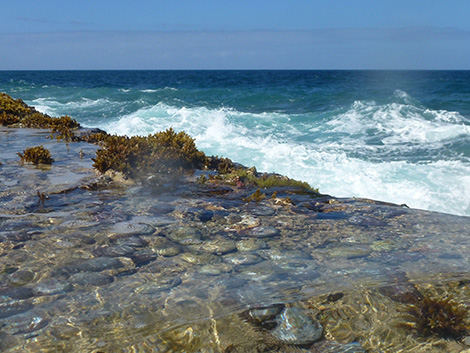Abalone rarely move far from a snug spot on a reef but about 60,000 have travelled hundreds of kilometres north to Kalbarri, courtesy of a Fisheries research project.
After the marine heatwave in 2011 wiped out 99 per cent of the Roe’s abalone on the reefs north of Kalbarri, our scientists seized the opportunity to conduct an experiment and re-seed the reefs with wild adults and hatchery-bred juveniles.
Adult Roe’s abalone were carefully captured from inshore reefs: 6,000 from Lucky Bay, near Esperance, and 3,000 from the Perth metropolitan area.
It was a long and difficult task to collect the abalone in good condition, transport them to Kalbarri then release them by hand in five monitored reef sites when the weather permitted.
The reefs at Kalbarri are more exposed than those around Perth and, with big swells on most days, conditions are tougher for abalone.

The exposed reefs at Kalbarri – a tough environment for abalone.
The venture was helped by the local abalone industry, particularly commercial abalone fisher John Craike, who worked with our staff to get the wild stock, plus 50,000 hatchery juveniles, settled safely.
A few months ago, a handful of tiny juvenile abalone was detected at a release site, a promising sign that some of the newcomers were able to breed in the rough conditions.
This is the first re-seeding of Roe’s abalone on such a big scale; if left to nature, it would take many decades for the population to recover, if at all.
However, a release of more hatchery-bred abalone in November will bring the project to an end and it may be decades before the Kalbarri abalone fishery has the potential to produce the eight tonnes a year that was commercially harvested before 2011.
To protect recovering stocks, there is a ban on all abalone fishing north of Moore River until further notice.
The re-seeding project was funded by the Federal Government’s Australian Seafood Cooperative Research Centre (ASCRC).